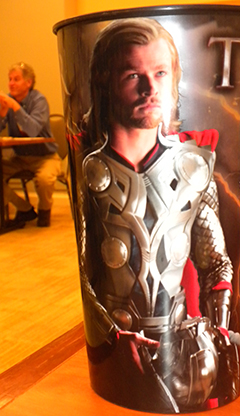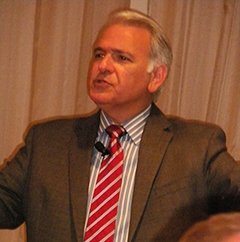IMDA Holds 2nd Annual Educational Symposium
- Published: December 02, 2014, By Claudia Hine
The In-Mold Decorating Assn. (IMDA), Scottsdale, AZ, held its second annual symposium, “IML/IMD: Concept to Completion,” October 22-23 at the Doubletree-Chicago North Shore Conference Center in Skokie, IL. IML refers to in-mold labeling of packaging, whereas IMD refers to in-mold decoration of durable products.
 Continuing its educational focus, the symposium tracked the real-world experiences of industry professionals that have achieved success with in-mold decoration. PFFC is a media sponsor of the event, which drew more than 50 attendees. Below is a brief review of several of the sessions.
Continuing its educational focus, the symposium tracked the real-world experiences of industry professionals that have achieved success with in-mold decoration. PFFC is a media sponsor of the event, which drew more than 50 attendees. Below is a brief review of several of the sessions.
Following opening remarks by Joe Hirtzer, president of Global Packaging Intl. and VP of IMDA, and Myra Schultz, IMDA operations manager, Ron Schultz, IMDA executive director, kicked off the event with “Understanding IML,” taking attendees through the technology’s history, which had its beginning in the US in 1979 when Procter & Gamble produced Downey fabric softener using an in-mold label. His presentation covered in-mold decoration of durable products as well as the three types of in-mold labeling:
- Blow Mold IML (IML-B)
- Injection Mold IML (IML-I)
- Thermoform IML (IML-T)
Attendees watched video of all the processes as Schultz presented the benefits of each technology and the manufacturing steps removed from the process of labeling packages as compared to the use of pressure-sensitive labels.
Roman Artz, technical product manager at Inland Label, LaCrosse, WI, presented a session on “Making the Move to IML/IMD.” Consumer product companies are making the switch due to increased competition, sustainability benefits, increased shelf appeal, barrier opportunities, container shapes, and to rebrand/refresh a mature product line.
“Collaboration is key,” he says, and success depends on a great partnership among the label converter, molder, mold designer, brand owner, automation designer, and the substrate supplier. The transition to IML can take four to six months, he said, and up to a year is not unrealistic. Offset printing is most often used for multiple SKUs with varying quantities, while flexography and gravure are better for high volume, low SKU runs.
Winners of the eighth annual IMDA awards were previously announced in August, and the winning products were on display at the symposium. Judge Clare Goldsberry, senior editor of Plastics Today, covered the competition in “Picking Winners from Great Products,” taking attendees through the challenging process of judging the entries.
 Attendees were offered a choice of four workshops on both days of the symposium. The workshops covered the following subjects:
Attendees were offered a choice of four workshops on both days of the symposium. The workshops covered the following subjects:
- Durable Consumer Products—moderated by Dave Ziegenhorn, Magenta; Lisa Skul, SFH; and Bob Travis, InkWorks
- Durable Industrial Products—moderated by Rand Scherger, Rockwell; Bill Buettner, Serigraph; Brent Johnson, Serigraph
- Consumer Package—moderated by Hubert Kittelman, Marbach
- Family Sets: Consumer Package—moderated by Roman Artz, Inland Label; and Jon Knight, Treofan Industries
In the Family Sets workshop, a family of drink cups with gravure-printed labels that feature characters from the Thor movie were among the products discussed. The challenge with these labels came from the laminating adhesive that wanted to break away from the ink layer. The presenters said six to eight adhesives were tested until they found the right one for the application, which was a two-part system.
Currently offset-printed roll to sheet labels are the dominant method for IML. Roll-fed IML will continue to grow as it helps to eliminate waste from handling stacks of labels, which are often thrown away as one run ends and another set is started.
KEYNOTE ADDRESS
Mike Ferrari, president/founder of Ferrari Innovation Solutions LLC, Islamorada, FL, gave the keynote address, “The Golden Age of Print: How IML/IMD Can Prosper.” In the age of social media, the printing industry has moved from mass production to mass customization, he said, offering numerous examples of personalized products, many designed to appeal to children, such as photo-personalized Goldfish cracker packages, but liquor bottle labels also can be personalized as gifts for adults.
 The average grocery store has 48,000 SKUs and it’s growing, he says. But it’s not just about the retail shelves anymore. “We are in a multi-channel environment now. Because shopping habits are changing, brands need to look beyond the shelf to other channels that are occurring. The challenge will be how to take advantage of all the changes and leverage them so IML can prosper.”
The average grocery store has 48,000 SKUs and it’s growing, he says. But it’s not just about the retail shelves anymore. “We are in a multi-channel environment now. Because shopping habits are changing, brands need to look beyond the shelf to other channels that are occurring. The challenge will be how to take advantage of all the changes and leverage them so IML can prosper.”
Today we have personalized tissue boxes, QR codes on ketchup bottles, and personalized soda on shelves, said Ferrari. “Packaging is interactive and offers two-way communication. This is the new norm. We’re in a connected world and that has changed everything.”
Digital printing is improving product value by providing a new consumer experience, which is driving revenue growth. Some CPGs have seen 3%–4% revenue growth based on personalized packaging. He called digital the “creative fuel” for IML/IMD. The creativity comes when you look at what the shopper is doing. Then you can see how to reinvent your business. Consider the ability to create relevancy, engagement, and interaction. “That’s where you change the consumer experience,” he said.
Day 1 events concluded with the presentation of the IMDA Awards and the association’s annual member meeting.
On Day 2 of the symposium, Duncan Henshall, market director, Taghleef Industries, presented a session entitled, “Made the Move into IML—What Next?” He offered thoughts on how to build upon your platform—current product portfolio, capability and service, and market volume. These included:
- Prove and refine the quality record and product performance
- Improve your service, both supply and technical
- Become trusted
- Offer a wide range of products and services
- Demonstrate ability to innovate so you are discussing opportunities with customers
- Capture opportunities and build the business
Henshall shared a case study of Smart Balance, which changed to a new square IML container that provides improved shelf visibility with larger billboard space for bolder graphics.
All attendees of the symposium received a directory of member companies, technical test procedure guidelines, and a glossary of in-mold terms.




